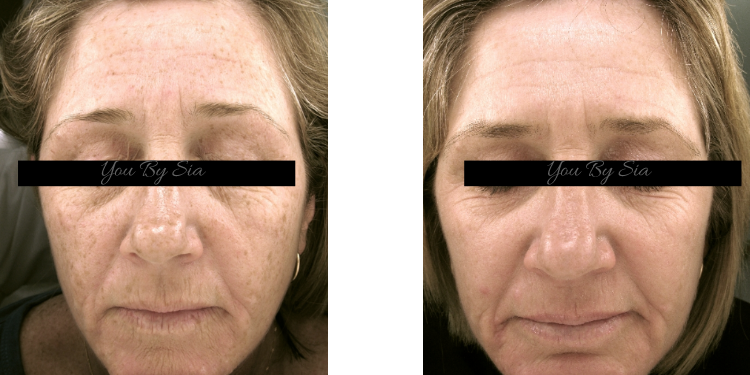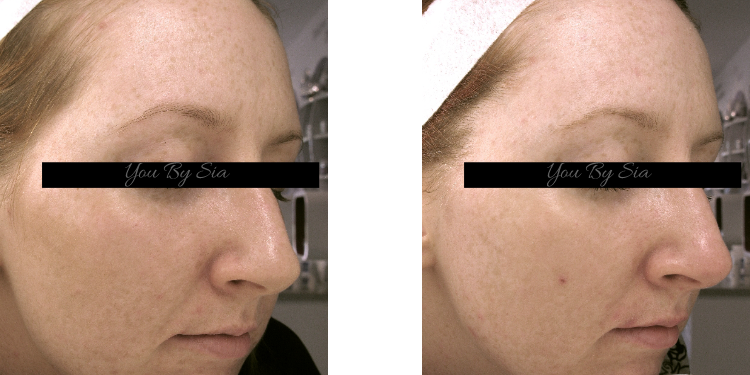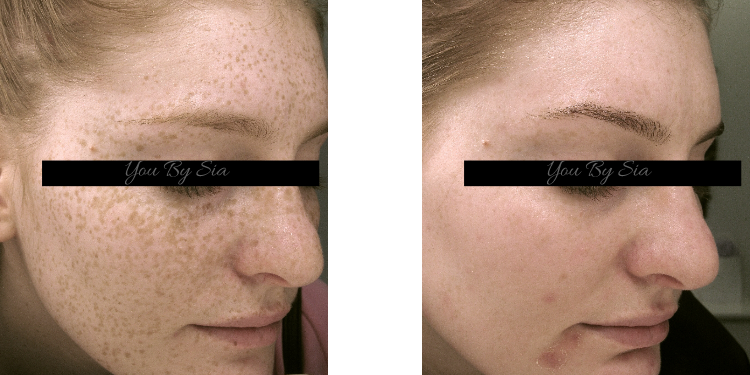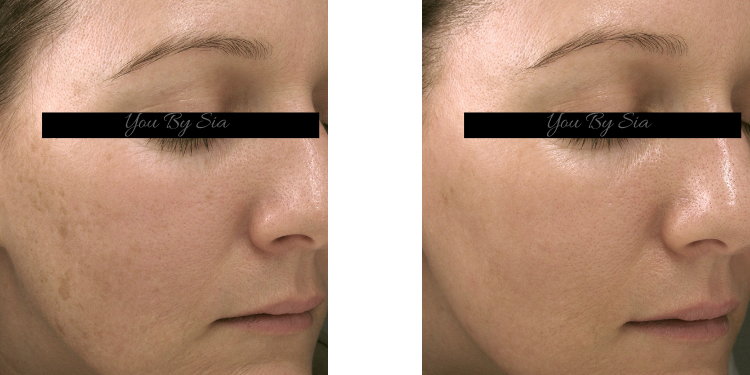
Laser Pigmentation Treatment
Home > Laser Pigmentation Treatment
Laser Pigmentation Treatment
Pigment is the colour in your skin. When you have too much in one area, it is called “hyper-pigmentation”, and the spots appearing on your skin as a result are called “pigmented lesions”. These dark lesions usually result from the overproduction of melanin, a natural skin pigment. Although pigmentation is not harmful, it can still lower your self-confidence and therefore, needs proper treatment. The treatment for hyperpigmentation was difficult in the past but with the help of Laser pigmentation treatment, it is completely safe and effective for all skin types today.
Take a look at the results
How Our VL Pigmentation Treatment Works
You By Sia’s Laser technology in Bondi Junction is effective and advanced when it comes to removing pigmentaion. It is the next-generation in treating multiple skincare concerns including hyperpigmentation. The Pigmentation treatment removes the appearance of spots and skin hyper-pigmentation by targeting the melanin in the darkened area and dispersing it.
The tiny fragments of the pigment are then cleared through a natural process. This clears all of the pigmentation layers, to reveal even-toned, unblemished skin. As always, Laser pigmentation treatments are specially designed for your comfort, and are completely safe and effective for light to medium skin types.
Benefits Of Laser Pigmentation Treatment
Reduction of capillaries, blood vessels &
Reduces pigmentation
Improved skin tone and texture
Softens fine lines and wrinkles
Tightens pores and skin
What To Expect From Laser Pigmentation Treatment
We recommend a course of 3-4 treatments carried out fortnightly. This will ensure maximum long term results are achieved. There is minimal discomfort and downtime. Some pigmentation and vessels may appear darker but will subside in approximately 2 weeks. Treatments are suitable for light to medium skin tones. You must avoid any medications or ointments for at least 48 hours before the procedure.
We recommend prepping the skin 2 weeks prior to the treatment using our Clinicals Skincare range. This will ensure the treatment performed has minimum complications. Post-treatment, we recommend using the Clinicals Skincare to assist with the wound repair process and to provide the skin with all nutrients and ingredients needed to create healthy new collagen and elastin for maximum results.
Pricing & Booking
Prepay for 4 Treatments - Save 20%
LUXE VIP Members - Save 30%
FAQs
-
Laser pigmentation treatment is a non-invasive skin therapy that targets uneven skin tone, hyperpigmentation, redness, and signs of ageing such as fine lines. It uses a form of advanced intense pulsed light (IPL) technology, which operates on Advanced Fluorescence Technology (AFT).
The light energy breaks down excess pigment into smaller particles, which are then naturally cleared by the body’s immune system. Simultaneously, it stimulates collagen production, improving skin texture and firmness.
-
Laser pigmentation removal is a targeted light-based treatment designed to correct a variety of pigmentation-related issues and improve overall skin clarity. It effectively addresses the following concerns:
Sun Damage and Age Spots: Helps reduce visible sunspots, liver spots, and other pigmentation caused by prolonged UV exposure.
Melasma and Hormonal Pigmentation: Minimises dark patches triggered by hormonal fluctuations, pregnancy, or use of oral contraceptives.
Post-Inflammatory Hyperpigmentation (PIH): Fades residual dark marks that remain after acne, minor injuries, insect bites, or skin irritation.
Vascular Pigmentation and Redness: Improves appearance of redness, visible capillaries, and rosacea-related flushing that often accompany pigmented areas.
Dullness and Early Signs of Ageing: Boosts skin radiance, improves texture, and reduces the appearance of fine lines by stimulating collagen production.
-
A complete course of six laser sessions is generally recommended to achieve optimal and long-lasting results. While some individuals may begin to notice visible improvement after the first session, results are more consistent and noticeable as the treatment progresses.
Each session contributes to a gradual reduction in pigmentation, redness, and uneven skin tone, while also enhancing the skin’s overall texture and brightness. For the best outcome, it is important to follow the full treatment plan advised by the clinic and maintain appropriate skincare between sessions.
-
Yes. The treatment uses advanced light-based technology that specifically targets excess melanin in the skin, breaking it down into smaller particles which are then naturally cleared by the body.
It is effective on both surface-level and deeper pigmentation, making it a versatile option for individuals with varied pigmentation concerns. However, as with any treatment, results may vary based on skin type, severity of pigmentation, and individual response, so a professional skin assessment is recommended before starting.
-
The treatment can be safely applied to various areas of the face and body where pigmentation, redness, or uneven skin tone is present. It is most commonly used on:
The face, including the forehead, cheeks, nose, and jawline, to address pigmentation, redness, and fine lines
The neck, where signs of sun damage and discolouration often appear
The décolletage (upper chest), which is prone to sunspots and uneven tone
The shoulders and arms, for treating freckles and sun-induced pigmentation
The hands, which often show early signs of ageing such as age spots and dullness
-
Laser pigmentation removal is known to deliver noticeable improvement in reducing pigmentation across different skin types. It works by using advanced light-based technology that targets areas of excess melanin, which is responsible for dark spots and uneven skin tone. The light gently breaks down the pigment beneath the skin's surface, allowing the body to gradually clear it away.
Most people observe a visible reduction in pigmentation within a few sessions, although results are more prominent after completing the recommended course of treatment. With consistent use, laser pigmentation removal can significantly even out skin tone and improve clarity, especially when supported by proper skincare and sun protection.
-
Yes, pigmentation can return after laser pigmentation removal treatment, especially if the underlying causes are not managed. While the treatment effectively reduces existing pigmentation by breaking down excess melanin, it does not prevent new pigmentation from forming.
Factors such as unprotected sun exposure, hormonal changes, skin inflammation, or certain medications can trigger the recurrence of pigmentation. To maintain long-term results, it is essential to follow a proper skincare routine, use broad-spectrum sunscreen daily, and avoid known triggers wherever possible.
Regular maintenance sessions and professional skin assessments may also be advised to keep the skin clear and even-toned over time.
-
Yes, it is safe for most skin types, including sensitive and acne-prone skin. The treatment delivers light energy in a controlled way, targeting pigmentation without damaging surrounding tissue. While mild redness may occur in sensitive skin, it typically subsides quickly. It is always advisable to have a professional skin assessment before starting to ensure the treatment is appropriate for your skin condition.
-
The results from Laser pigmentation removal treatment are long-lasting but not permanent. The treatment effectively reduces existing pigmentation, but new pigmentation can develop over time due to factors such as sun exposure, hormonal changes, or skin inflammation. To maintain the results, it is important to use sun protection daily, follow a suitable skincare routine, and consider occasional maintenance sessions if needed.
-
Since darker skin contains more melanin, there is a slightly higher risk of side effects such as temporary darkening (hyperpigmentation) or lightening (hypopigmentation). However, when performed by a qualified professional with experience in treating diverse skin tones, the procedure can be both safe and effective.
A full skin assessment is essential before starting, to determine suitability and adjust treatment settings accordingly. Pre- and post-treatment care also play an important role in reducing risks and achieving even-toned results.
-
Redness: Usually appears after treatment and fades within a few hours to 48 hours.
Warmth or Tingling: A mild, temporary sensation during or immediately after the session.
Temporary Darkening of Pigmentation: Treated spots may darken before gradually fading.
Skin Sensitivity: Some may experience mild swelling or tenderness, particularly in sensitive areas.
Pigment Changes in Darker Skin Tones: Slight risk of hyperpigmentation (darkening) or hypopigmentation (lightening), which tends to be short-term.
-
Laser pigmentation removal treatment is mildly uncomfortable but not painful. Most people feel a warm snap on the skin, similar to a light rubber band flick. No numbing is usually required, and any discomfort fades quickly after the session.
-
A typical Laser pigmentation removal treatment session lasts around 20 to 30 minutes, depending on the size and number of areas being treated. For smaller zones like the cheeks or nose, the session may be shorter, while larger areas such as the full face or décolletage may take a bit longer. The procedure is quick and convenient, making it suitable even for those with a busy schedule.
-
Proper skin preparation helps improve treatment effectiveness and reduces the risk of irritation. You should:
Use prescribed or recommended skincare (usually clinic-grade) for at least two weeks prior to treatment. This helps to strengthen the skin and prepare it for light-based therapy.
Avoid direct sun exposure for at least 5 to 7 days before your session, as sun-damaged or tanned skin is more sensitive and prone to side effects.
Stop using active skincare ingredients like retinoids, AHAs, BHAs, or acne creams at least 48 hours before treatment.
Refrain from waxing, threading, or harsh exfoliation in the area to be treated for a few days before the session.
Do not apply fake tan or bronzing products for at least one week before the appointment.
Avoid makeup, creams, or SPF on the treatment area on the day of your session.
-
Aftercare is important to support healing and protect the skin following Laser pigmentation removal treatment. Key aftercare steps include:
Protect your skin from sunlight by staying indoors as much as possible for at least a week and applying a high-SPF sunscreen every day.
Stick to mild skincare – avoid any exfoliants, retinol-based products, or treatments that may irritate the skin for a few days.
Let the skin heal naturally by not touching, picking, or rubbing the treated area, even if it begins to flake or darken.
Keep the area hydrated using a gentle, fragrance-free moisturiser to soothe and support skin recovery.
-
Laser pigmentation removal treatment involves minimal to no downtime. Some may experience:
Mild redness or warmth, which usually fades within a few hours
Temporary darkening of pigmentation, which naturally fades over a few days
While the skin may feel slightly sensitive, it does not typically interfere with daily routines. Light makeup may be worn if the skin is not irritated.
-
Laser is a more advanced form of IPL (Intense Pulsed Light) technology. Here is how it compares:
Precision: Laser pigmentation removal uses filtered light for more accurate targeting of pigmentation and vascular lesions
Comfort: It offers a more controlled and gentler treatment experience than traditional IPL
Effectiveness: Laser pigmentation removal may deliver better results with fewer side effects, particularly for treating redness and stubborn pigmentation
Safety: The treatment is better suited for sensitive skin types due to its refined energy delivery
While both are used for pigmentation concerns, Laser pigmentation removal offers enhanced results with improved comfort and safety.






